Introduction
A personal SWOT analysis is not just a self-assessment; it's a powerful tool for personal development. By examining your strengths, weaknesses, opportunities, and threats, you can gain self-awareness and strategically navigate your career. In this article, we will explore the importance of conducting a personal SWOT analysis and provide practical steps for performing one effectively.
Whether you're a CFO or a professional in any field, this article will equip you with the knowledge and insights to leverage your strengths, address weaknesses, seize opportunities, and mitigate threats. Get ready to take charge of your professional growth and shape your future success.
Why You Need a Personal SWOT Analysis
A personal SWOT analysis transcends mere self-assessment; it's a strategic compass for personal development. It empowers you with self-awareness, spotlighting your inherent talents and pinpointing areas ripe for enhancement. By examining your professional achievements and the unique perspectives you've gleaned from diverse industries, you can identify how to leverage your experiences to make strides in your career.
Consider the triumphs of Kavida.ai, a nimble $1 million company whose standout product is akin to a PO management system's spreadsheet simplicity. Despite the tech's allure, their success underscores a vital truth: enduring success is less about technology and more about the synergy between people.
Diving into a personal SWOT analysis prompts pivotal questions that shape your professional narrative. What transformative impacts have you made in your projects or business ventures, evidenced by quantifiable outcomes? Which global insights can you harness to steer your organization or future employer into uncharted markets?
The alliances you've forged through your professional network are not just connections—they're potential strategic partnerships that could pivot your company's competitive edge.
Weaknesses, on the other hand, are the Achilles' heel that can tilt the scales against you or your organization. A department grappling with limited financial resources, for instance, is a glaring vulnerability. To navigate such weaknesses, introspective inquiries are essential.
What are the frailties within our team's culture or management? How resilient are we in the face of change?
A personal SWOT analysis is not solely about introspection; it's a proactive tool for charting a path forward. It's about asking yourself: what are my crowning achievements and how can they shape my future roles? With the clarity it provides, you're not just preparing for the future—you're actively sculpting it.
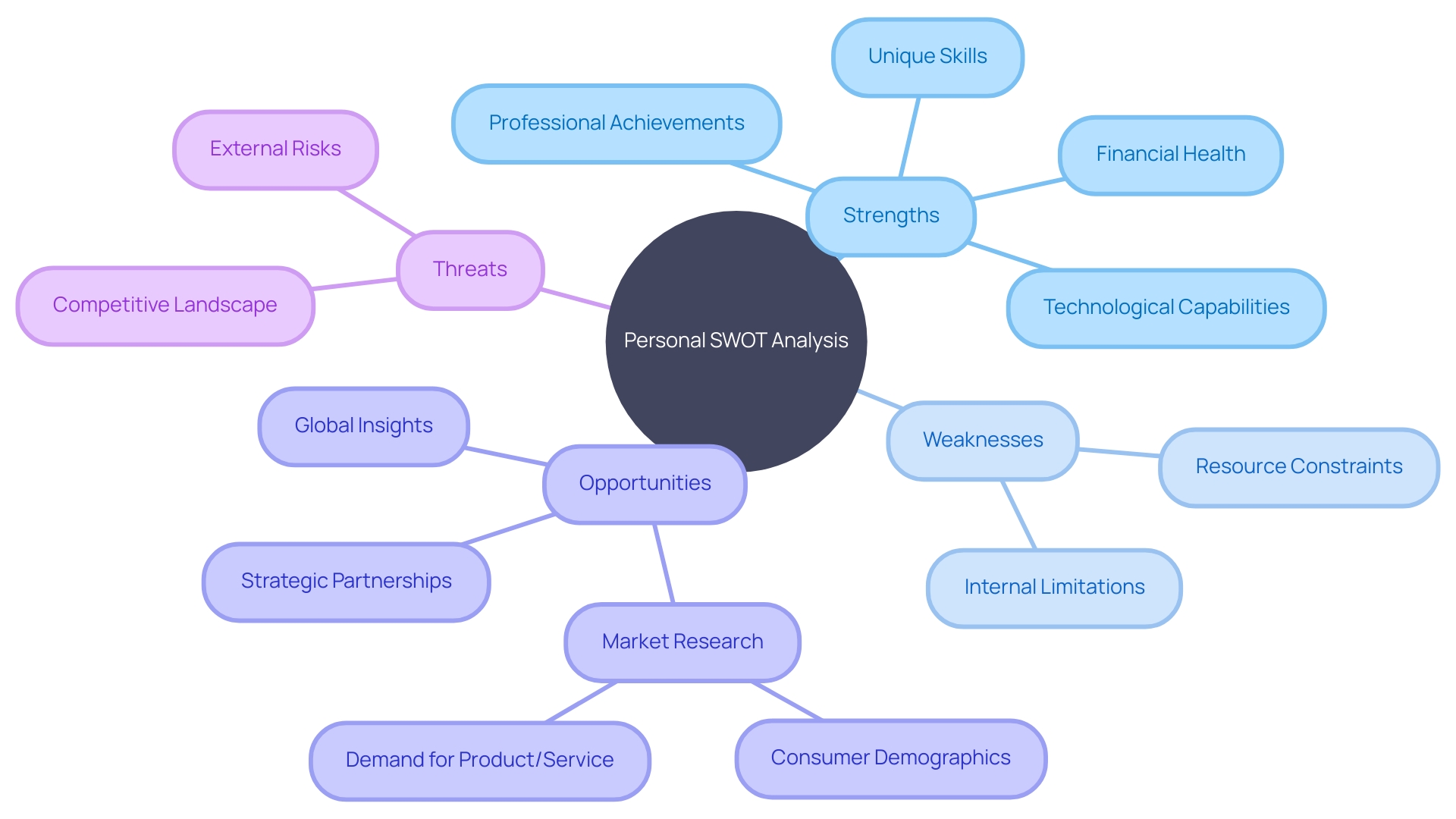
How to Conduct a Personal SWOT Analysis
To effectively utilize a personal SWOT analysis, consider these refined steps:
-
Leverage Your Strengths: Reflect on your unique blend of talents, taste, and experiences. Identify how your specific skills and knowledge give you a competitive advantage. As one expert puts it, it's the unique leverage that sets you apart from competitors and alternatives, often found at the intersection of your above-average talents and experiences.
-
Acknowledge Your Weaknesses: Be honest about your shortcomings, whether it's a lack of resources, experience, or certain skills. Ask yourself critical questions about where your company or department may be vulnerable, such as potential weaknesses in team culture or management.
-
Seize Opportunities: Look for external factors like market trends or networking events that could facilitate your growth. For instance, consider how adopting a proactive approach to visibility, as exemplified by innovative companies like Kavida.ai, can help in recognizing and capitalizing on opportunities.
-
Anticipate Threats: Recognize challenges that could obstruct your path to success. It's important to understand that sometimes the greatest threat to a business's success can be the business itself, as in the case of Kavida.ai, where the simplicity and effectiveness of their solution could be overshadowed by internal limitations.
By examining each of these elements through the lens of real-world examples, personal experiences, and market dynamics, you can craft a more strategic and effective SWOT analysis. Remember, it's not just about the technology or tools you have; it's also about the people and the strategic alliances you forge. As you navigate this process, keep in mind the broader trends and statistics that impact life expectancy, the adoption of clean energy, or the prevalence of mental health issues globally, as these can influence market conditions and competitive landscapes.
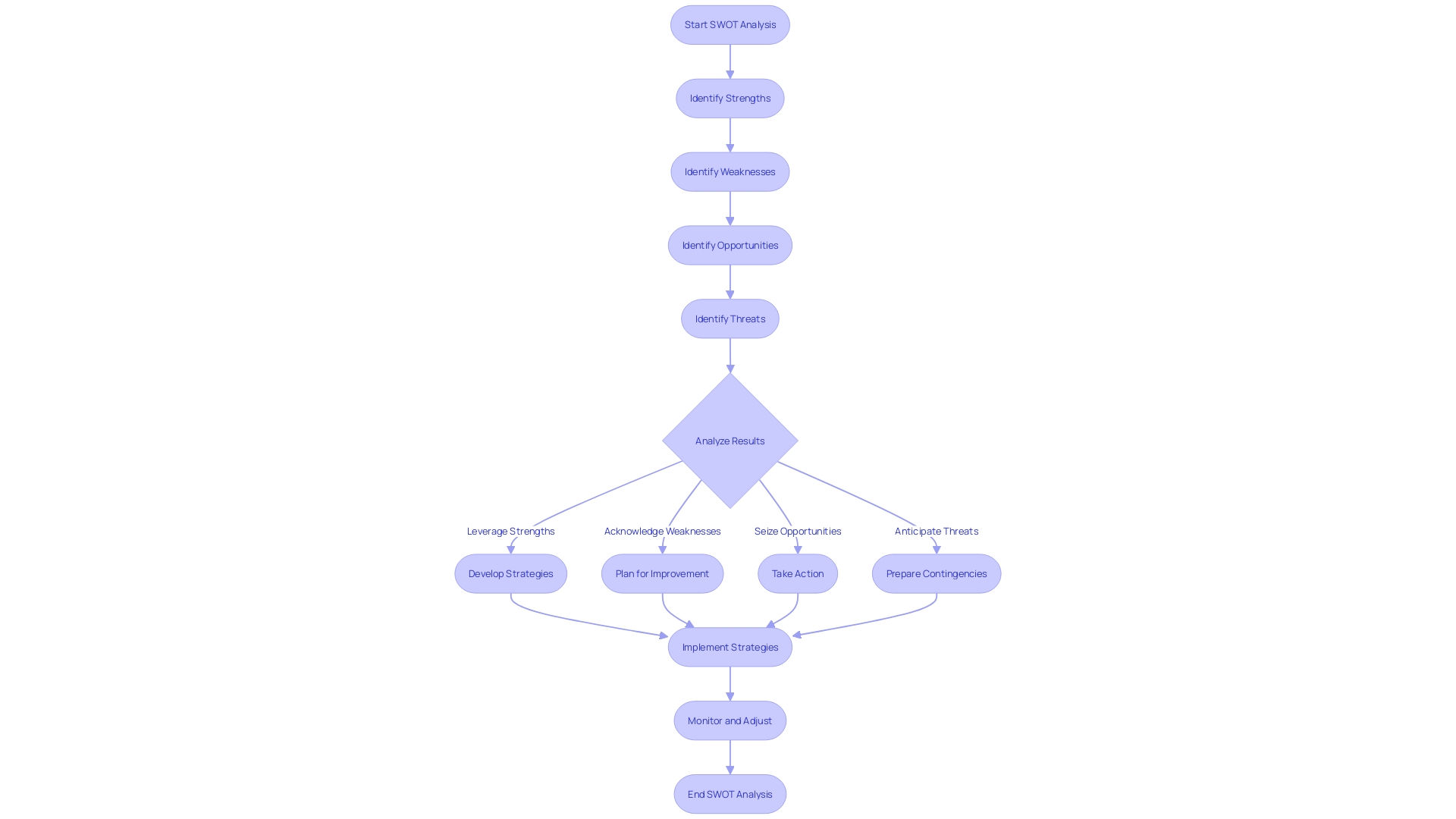
Strengths Analysis
When crafting your personal SWOT analysis, the examination of your strengths serves as the foundation for both personal and professional strategic planning. It's about pinpointing your intrinsic assets that distinguish you within a competitive landscape. These assets may encompass a variety of competencies, such as specialized technical prowess, proven leadership, innovative thinking, adept problem-solving, and articulate communication.
They are the skills and attributes that not only differentiate you from your peers but also add unique value.
To effectively identify these strengths, consider your most notable achievements and the positive feedback you've received, as they are indicative of the areas where you excel. Analyze transformative contributions you've made in past roles—whether it's through leading successful projects, driving operational improvements, or steering complex negotiations—and the measurable impact they've had on business outcomes.
In the context of a broader organizational setting, strengths might manifest as robust financial health, cutting-edge technological infrastructure, or a highly skilled workforce. Recognizing these strengths is not just an exercise in self-assessment but a strategic maneuver to leverage them for future endeavors and to forge a path that aligns with your career aspirations and the objectives of your business.
In today's dynamic and interconnected global market, reflective questions such as 'What unique global perspectives can I bring to the table?' or 'What strategic alliances could I establish through my professional network?' become increasingly relevant.
These introspections can unlock new opportunities and help you chart a course for growth that is both ambitious and attainable.
As reported in the Global State of Business Analysis, understanding the evolving landscape of business analysis is crucial. The insights from this report, based on a survey of over 4,400 professionals, underscore the importance of recognizing one's strengths in navigating the challenges of an ever-changing industry. These findings not only reflect trends but also serve as a barometer for professionals to gauge their competitive edge.
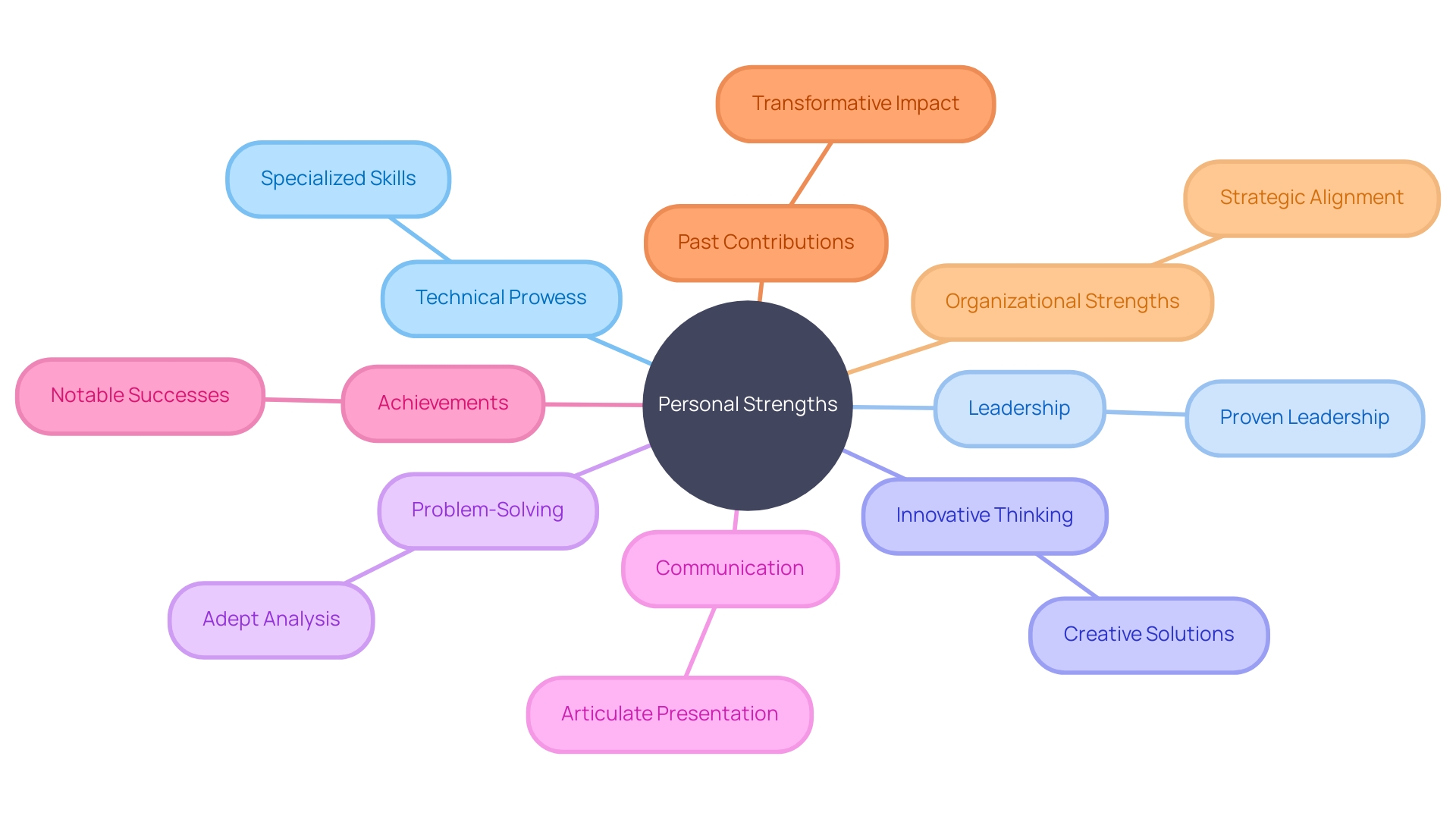
Weaknesses Analysis
A thorough weaknesses analysis in a SWOT framework involves a candid self-assessment to pinpoint deficiencies that could be stalling your personal growth or career advancement. This could encompass a range of elements from a lack of specific competencies, insufficient expertise in certain areas, to personality attributes that might be impeding your progress, or any other internal factors that potentially curtail your capabilities. Recognizing these areas is a crucial step in strategizing ways to address them, which might include pursuing additional training or seeking out resources and support.
Opportunities Analysis
External factors are critical in shaping the trajectory of your career and the prospects of business growth. A strategic SWOT analysis, focusing on opportunities, enables you to identify and leverage these external elements. It's essential to scan your industry for trends that could signal new avenues for expansion or improvement.
Networking, often underestimated, is another area ripe with potential; it opens doors to collaborations that could propel your personal and professional development forward. Additionally, educational programs offer a chance to refine your skills and knowledge base, keeping you competitive in a fast-changing market.
To grasp the full spectrum of opportunities, it's helpful to consider questions that probe deeply into your current capabilities and future potential. For instance, how can your unique experiences and insights pave the way to untapped markets? Or what strategic partnerships could you cultivate, drawing from your professional network?
These reflections not only pinpoint where you can grow but also reveal how to strategically position yourself or your company to seize these opportunities.
Remember, the most impactful opportunities often strike a balance between high potential for value creation and feasibility. It's the interplay between these factors that can turn a possibility into a tangible success. As you sift through potential opportunities, aim to identify those akin to 'gold-mines'—ones that promise significant value with manageable challenges.
This discerning approach will help you prioritize effectively, ensuring that your efforts are concentrated on the most promising prospects.
In your SWOT analysis, be sure to incorporate data and insights that reflect the current state of your industry. For instance, the burgeoning fields of data science and data analytics are flooded with courses and certificates, highlighting a demand for these skills that you could potentially fulfill. Understanding the competitive landscape is another layer that informs the opportunities you should consider.
The dynamic between your strengths and the external possibilities sets the stage for strategic decisions that could define your future success.
Threats Analysis
In the realm of strategic planning, identifying potential threats is a critical component of a thorough SWOT analysis. These threats could range from shifting market dynamics, evolving technology, competitive pressures, or even personal constraints that may hinder progress. For instance, a company might face threats from a new entrant in the market offering a similar product at a lower price, or a sudden shift in consumer behavior due to economic downturns.
Technological advancements could also render existing products or services obsolete. Personal limitations, such as a lack of certain skills or resources, could also pose significant challenges.
To effectively navigate these threats, it is essential to recognize and strategize around them. For example, by conducting market research, a business can understand the demographic specifics, such as age, wealth, and interests, which can inform the demand for a product or service, the size of the potential market, and pertinent economic indicators. This insightful data aids in crafting targeted strategies that not only mitigate the risks posed by these threats but also turn potential challenges into opportunities for growth and innovation.
Moreover, engaging in regular SWOT analyses allows for an agile response to an ever-changing business environment, ensuring that strategies remain relevant and effective. As businesses reassess their positions within their respective industries, they can adjust their focus, leveraging their strengths, such as a skilled workforce, robust financial health, or cutting-edge technology, to stand out and succeed despite the threats they face.
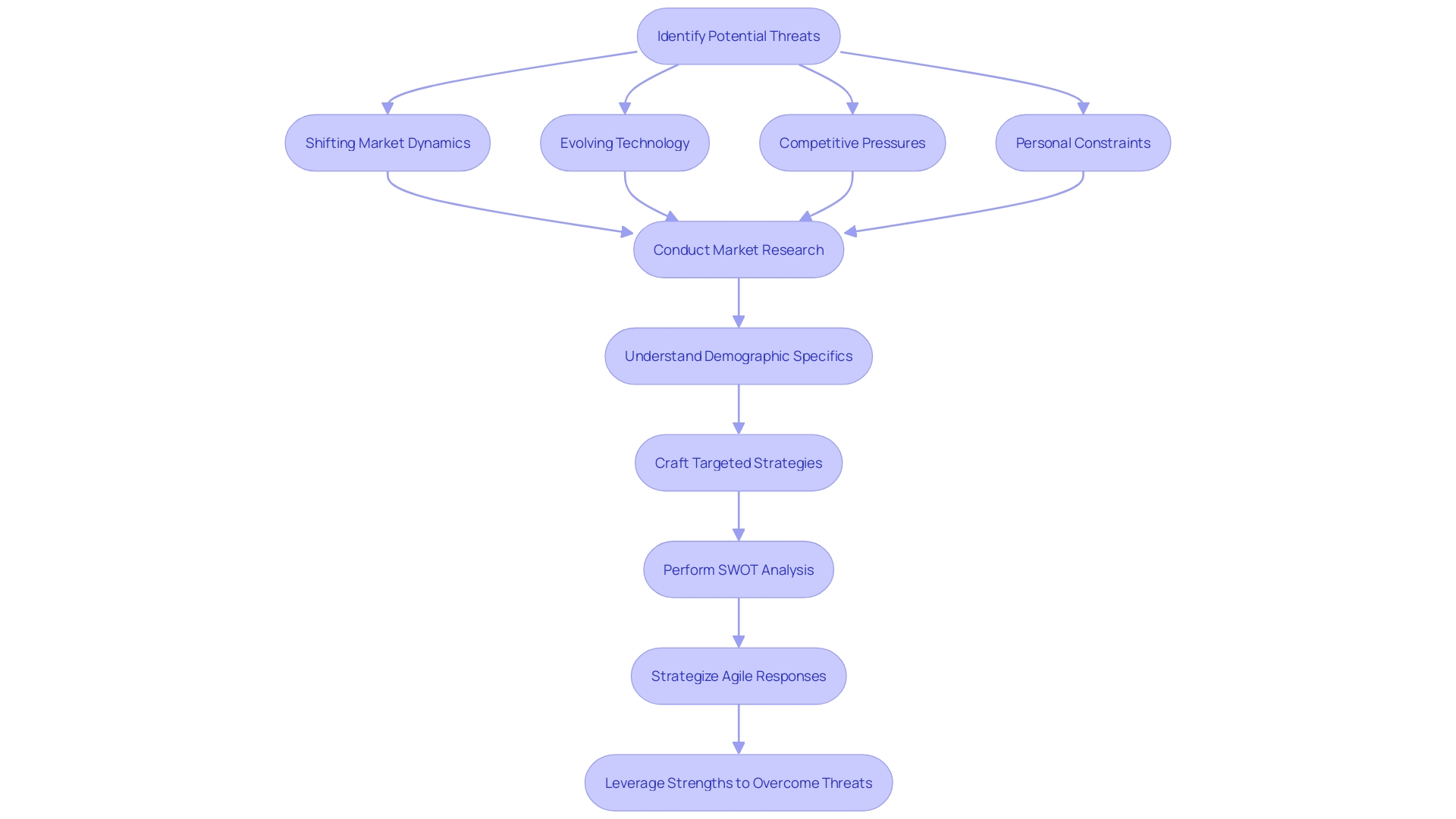
Examples of Personal SWOT Analysis
Delving into the intricacies of a personal SWOT analysis, consider the following examples tailored to the professional landscape:
- Strengths: These are your arsenal for success. For example, if you possess outstanding problem-solving capabilities, demonstrate leadership excellence, or wield effective communication skills, these are the strengths that set you apart from your peers.
- Weaknesses: Identifying areas for improvement is crucial. You might recognize a lack of expertise in a burgeoning field, a propensity to delay tasks, or a challenge in engaging large audiences effectively.
- Opportunities: These are the doors waiting to be opened. Attending networking events could broaden your industry connections, enrolling in an online course might sharpen your technical acumen, or a promotion within your organization could be on the horizon, signaling advancement.
- Threats: The landscape is replete with challenges. The job market may be increasingly competitive, an economic downturn could impact your sector, or there may be finite resources allocated for professional growth. For instance, a small but innovative company like Kavida.ai, despite its groundbreaking technology, acknowledges that enduring success hinges on more than just their product; it's the synergy between technology and the human element that truly propels a company forward.
In the ever-evolving professional arena, these components of SWOT analysis serve as a beacon to navigate through your career trajectory, ensuring you leverage your unique strengths, address weaknesses strategically, seize opportunities with foresight, and mitigate threats with informed action.
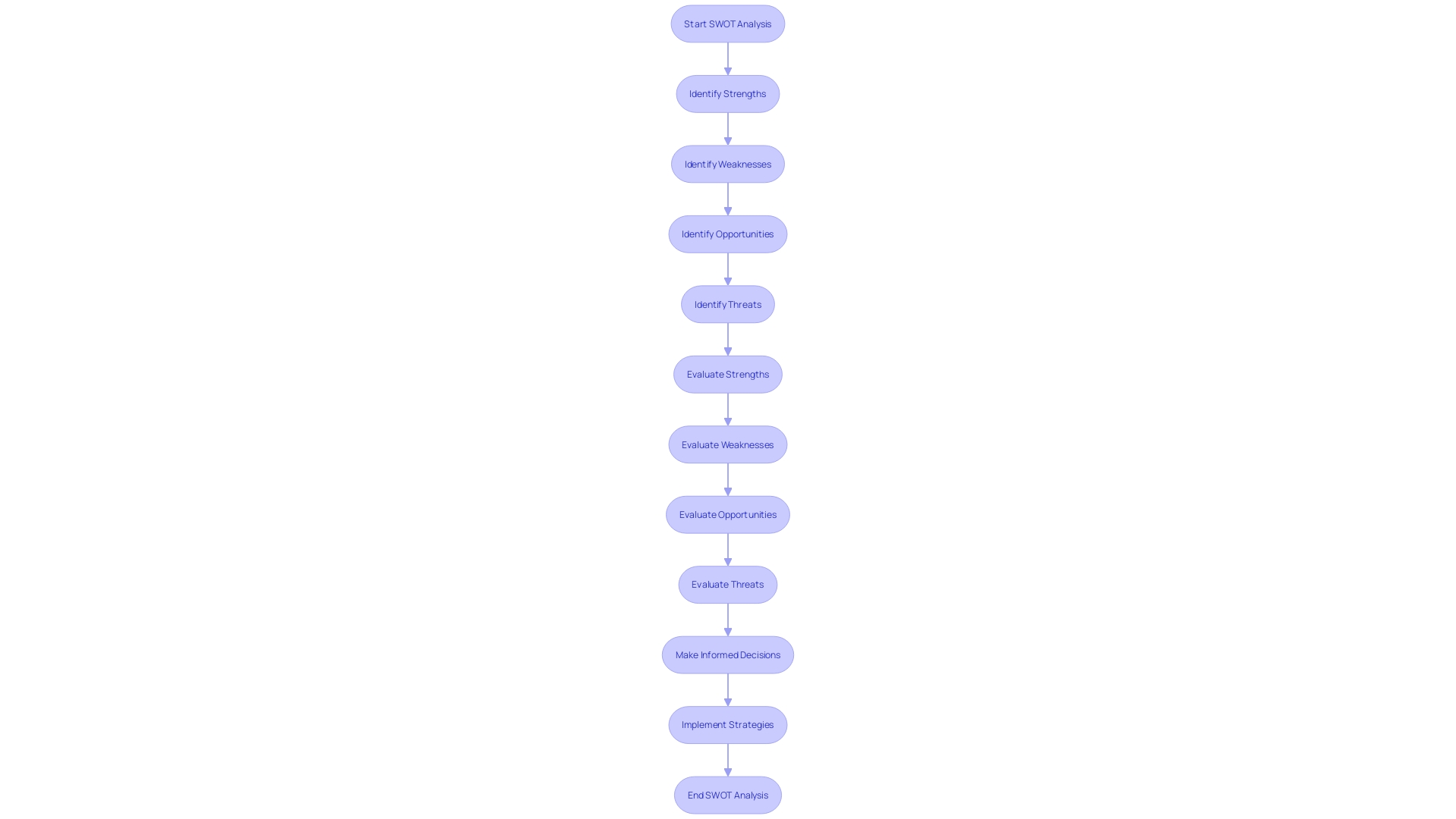
Creating an Action Plan from Your SWOT Analysis
To harness the full potential of a SWOT analysis, one must pivot from analysis to action, crafting a strategic action plan that is both systematic and detailed. Such a plan serves as a roadmap, outlining clear steps from the current situation to the desired objectives. Here's a strategic approach to developing this action plan:
-
Maximize Strengths: Identify your organization's unique attributes—be it superior technology, financial health, or exceptional talent—and tailor strategies to amplify these areas. For instance, if technological prowess is a strength, consider how it can be leveraged to outperform competitors or enter new markets.
-
Fortify Weaknesses: Weaknesses should not be stumbling blocks but rather opportunities for growth. Seek out training, mentorship, or partnerships that can build upon these areas. For example, if skill gaps are identified, targeted professional development could bridge the deficiency.
-
Exploit Opportunities: With clearly defined goals, seize opportunities that align with your strengths. This might involve capitalizing on market trends or changes in consumer behavior that are congruent with your organization's capabilities.
-
Neutralize Threats: Proactively develop contingency plans to address threats before they materialize. This may entail diversifying your product line to guard against market volatility or enhancing cybersecurity measures in response to growing digital threats.
A thoughtful action plan is not only a blueprint for achieving goals but also a testament to an organization's commitment to dynamic and responsive strategy formulation. It ensures that the insights from a SWOT analysis are not just theoretical exercises but catalysts for meaningful change and sustained success.
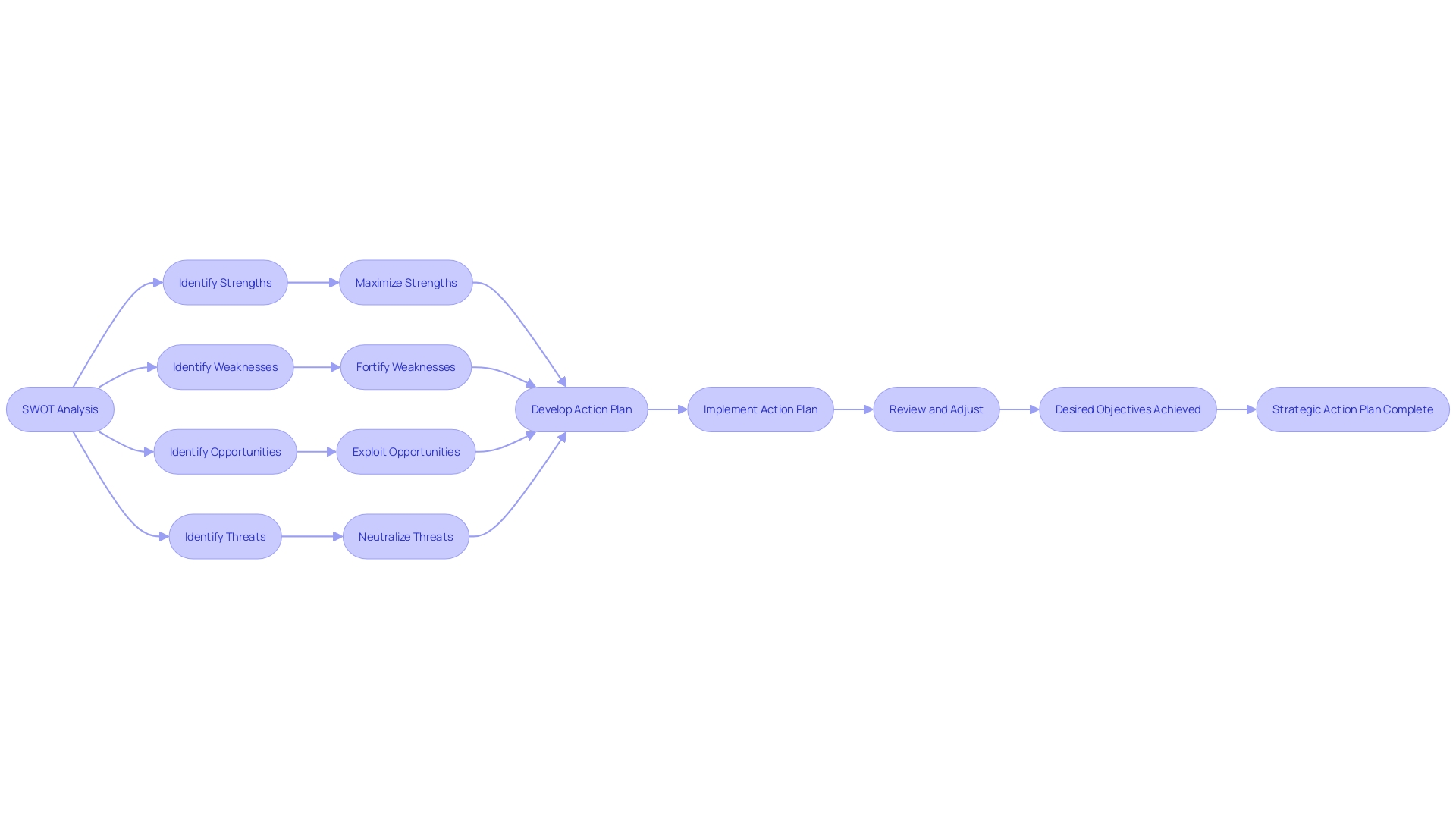
Tips for Effective Self-Assessment
For a robust self-assessment, integrity is paramount; recognize your true capabilities and limitations. Consider the experiences of employees at VIDA, who found immediate improvements in their routines and health by confronting their realities. Additionally, soliciting diverse viewpoints from colleagues or mentors, akin to how the City of Thunder Bay engaged its community in asset management, can provide a broader understanding of your strengths and areas for growth.
Setting attainable targets is crucial, much like the way institutions focus on specific policy areas or work types to achieve their missions. Your SWOT analysis should inform such goal-setting, aligning with your personal and professional ambitions. Furthermore, the iterative nature of SWOT, as emphasized by Dr. Tasha Eurich's research on self-awareness, necessitates regular review and updates to your analysis, ensuring it reflects any changes in your situation or environment.
In essence, approach self-assessment as an ongoing journey of self-improvement, with periodic evaluations akin to those in academia or public health programs that measure progress and foster growth. By adhering to these principles, you'll pave the way for genuine personal advancement and success.
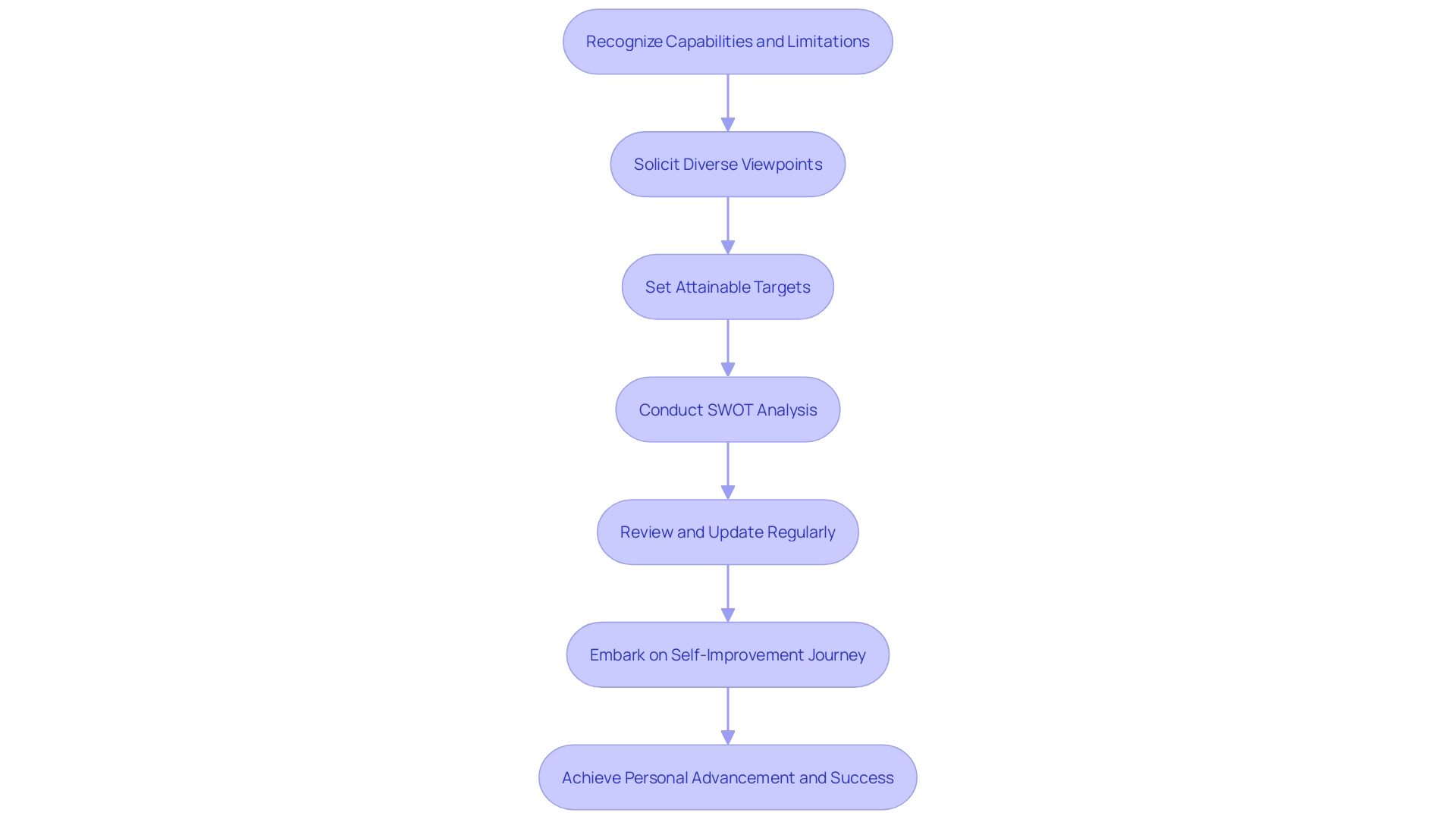
Conclusion
A personal SWOT analysis is a powerful tool for personal development, providing a strategic compass for navigating your career. By examining your strengths, weaknesses, opportunities, and threats, you gain self-awareness and insights to shape your professional growth effectively.
Conducting a personal SWOT analysis involves leveraging strengths, addressing weaknesses, seizing opportunities, and mitigating threats. It's important to recognize that enduring success is not just about technology but also about the synergy between people.
Crafting a personal SWOT analysis involves identifying intrinsic assets that distinguish you within a competitive landscape. Recognizing strengths is a strategic maneuver to leverage them for future endeavors. By considering questions that probe deeply into capabilities and potential, you can unlock new opportunities and chart a course for growth.
Identifying potential threats is crucial in a thorough SWOT analysis. By recognizing and strategizing around these threats, challenges can be turned into opportunities for growth and innovation.
Examples of personal SWOT analysis tailored to the professional landscape include identifying strengths, weaknesses, opportunities, and threats. These components serve as a beacon to navigate your career trajectory, ensuring you leverage strengths, address weaknesses strategically, seize opportunities, and mitigate threats.
To harness the full potential of a SWOT analysis, develop a strategic action plan. Maximize strengths, fortify weaknesses, exploit opportunities, and neutralize threats to achieve goals and sustain success.
For effective self-assessment, maintain integrity, solicit diverse viewpoints, and set attainable targets aligned with ambitions. Regularly review and update the analysis to ensure relevance.
Approach self-assessment as an ongoing journey of self-improvement, with periodic evaluations to measure progress and foster growth. By following these principles, you can take charge of your professional growth and shape your future success.




